coolant level FIAT DUCATO 244 2005 3.G Owners Manual
[x] Cancel search | Manufacturer: FIAT, Model Year: 2005, Model line: DUCATO 244, Model: FIAT DUCATO 244 2005 3.GPages: 258, PDF Size: 4.05 MB
Page 30 of 258
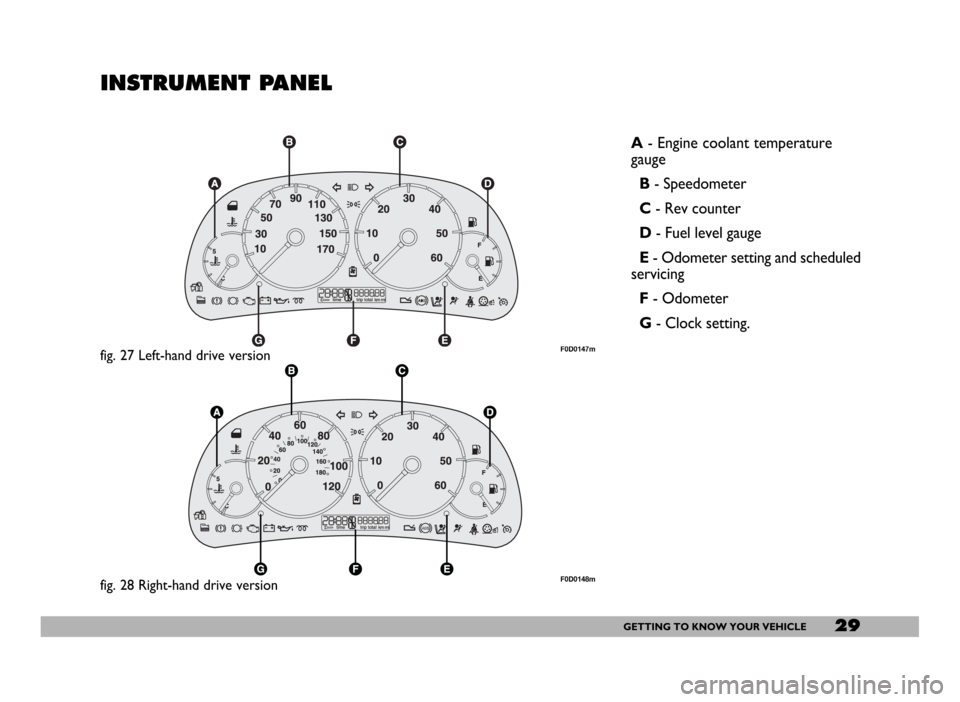
29GETTING TO KNOW YOUR VEHICLE
INSTRUMENT PANEL
A- Engine coolant temperature
gauge
B- Speedometer
C- Rev counter
D- Fuel level gauge
E- Odometer setting and scheduled
servicing
F- Odometer
G- Clock setting.
fig. 27 Left-hand drive versionF0D0147m
fig. 28 Right-hand drive versionF0D0148m
Page 39 of 258
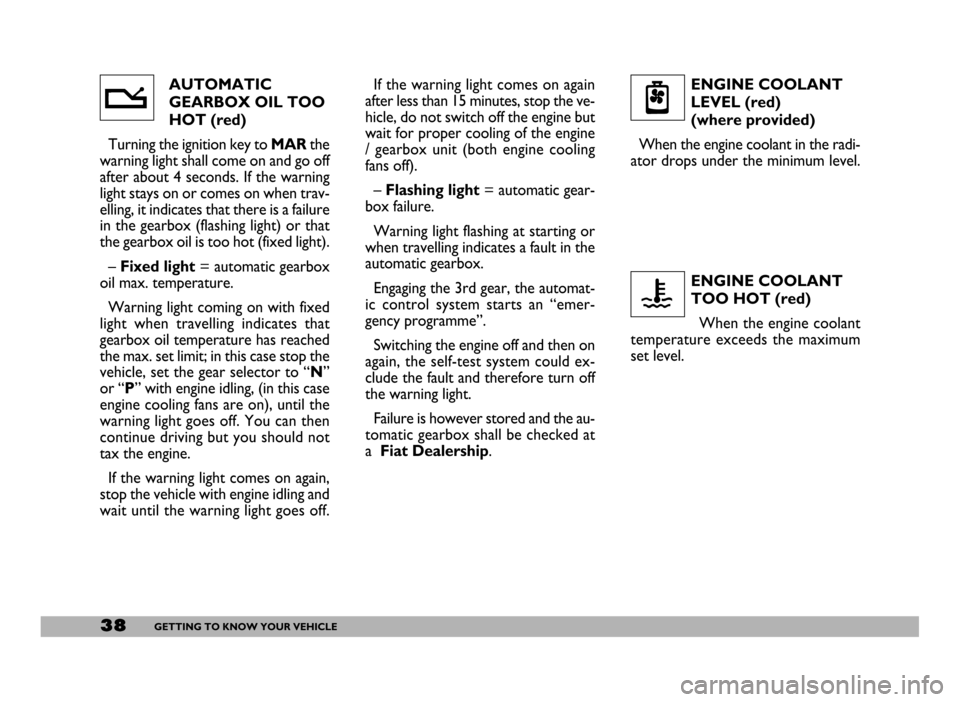
38GETTING TO KNOW YOUR VEHICLE
ENGINE COOLANT
LEVEL (red)
(where provided)
When the engine coolant in the radi-
ator drops under the minimum level.
n
AUTOMATIC
GEARBOX OIL TOO
HOT (red)
Turning the ignition key to MARthe
warning light shall come on and go off
after about 4 seconds. If the warning
light stays on or comes on when trav-
elling, it indicates that there is a failure
in the gearbox (flashing light) or that
the gearbox oil is too hot (fixed light).
– Fixed light= automatic gearbox
oil max. temperature.
Warning light coming on with fixed
light when travelling indicates that
gearbox oil temperature has reached
the max. set limit; in this case stop the
vehicle, set the gear selector to “N”
or “P” with engine idling, (in this case
engine cooling fans are on), until the
warning light goes off. You can then
continue driving but you should not
tax the engine.
If the warning light comes on again,
stop the vehicle with engine idling and
wait until the warning light goes off.If the warning light comes on again
after less than 15 minutes, stop the ve-
hicle, do not switch off the engine but
wait for proper cooling of the engine
/ gearbox unit (both engine cooling
fans off).
– Flashing light= automatic gear-
box failure.
Warning light flashing at starting or
when travelling indicates a fault in the
automatic gearbox.
Engaging the 3rd gear, the automat-
ic control system starts an “emer-
gency programme”.
Switching the engine off and then on
again, the self-test system could ex-
clude the fault and therefore turn off
the warning light.
Failure is however stored and the au-
tomatic gearbox shall be checked at
a Fiat Dealership.ENGINE COOLANT
TOO HOT (red)
When the engine coolant
temperature exceeds the maximum
set level.
u
t
Page 65 of 258
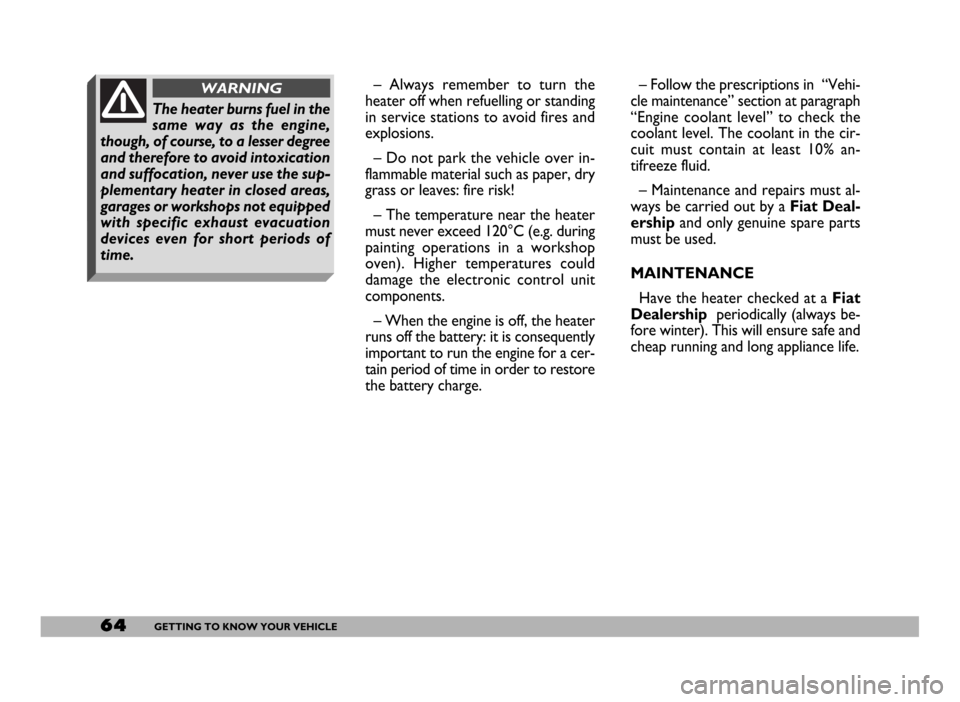
64GETTING TO KNOW YOUR VEHICLE
– Always remember to turn the
heater off when refuelling or standing
in service stations to avoid fires and
explosions.
– Do not park the vehicle over in-
flammable material such as paper, dry
grass or leaves: fire risk!
– The temperature near the heater
must never exceed 120°C (e.g. during
painting operations in a workshop
oven). Higher temperatures could
damage the electronic control unit
components.
– When the engine is off, the heater
runs off the battery: it is consequently
important to run the engine for a cer-
tain period of time in order to restore
the battery charge.– Follow the prescriptions in “Vehi-
cle maintenance” section at paragraph
“Engine coolant level” to check the
coolant level. The coolant in the cir-
cuit must contain at least 10% an-
tifreeze fluid.
– Maintenance and repairs must al-
ways be carried out by a Fiat Deal-
ershipand only genuine spare parts
must be used.
MAINTENANCE
Have the heater checked at a Fiat
Dealership periodically (always be-
fore winter). This will ensure safe and
cheap running and long appliance life.
The heater burns fuel in the
same way as the engine,
though, of course, to a lesser degree
and therefore to avoid intoxication
and suffocation, never use the sup-
plementary heater in closed areas,
garages or workshops not equipped
with specific exhaust evacuation
devices even for short periods of
time.
WARNING
Page 121 of 258
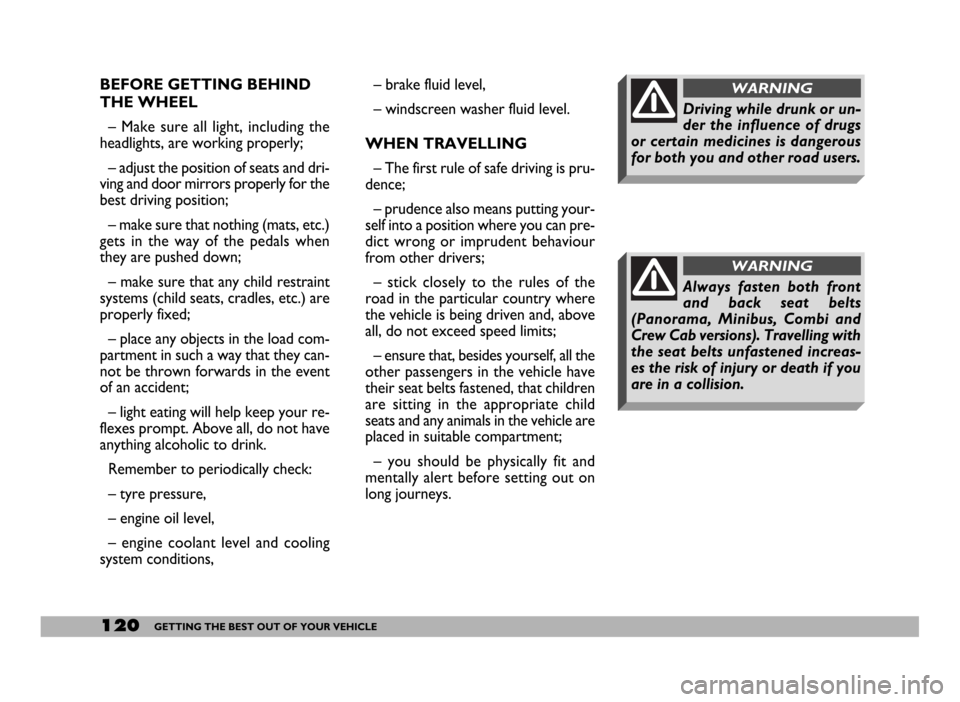
120GETTING THE BEST OUT OF YOUR VEHICLE
BEFORE GETTING BEHIND
THE WHEEL
– Make sure all light, including the
headlights, are working properly;
– adjust the position of seats and dri-
ving and door mirrors properly for the
best driving position;
– make sure that nothing (mats, etc.)
gets in the way of the pedals when
they are pushed down;
– make sure that any child restraint
systems (child seats, cradles, etc.) are
properly fixed;
– place any objects in the load com-
partment in such a way that they can-
not be thrown forwards in the event
of an accident;
– light eating will help keep your re-
flexes prompt. Above all, do not have
anything alcoholic to drink.
Remember to periodically check:
– tyre pressure,
– engine oil level,
– engine coolant level and cooling
system conditions,– brake fluid level,
– windscreen washer fluid level.
WHEN TRAVELLING
– The first rule of safe driving is pru-
dence;
– prudence also means putting your-
self into a position where you can pre-
dict wrong or imprudent behaviour
from other drivers;
– stick closely to the rules of the
road in the particular country where
the vehicle is being driven and, above
all, do not exceed speed limits;
– ensure that, besides yourself, all the
other passengers in the vehicle have
their seat belts fastened, that children
are sitting in the appropriate child
seats and any animals in the vehicle are
placed in suitable compartment;
– you should be physically fit and
mentally alert before setting out on
long journeys.
Always fasten both front
and back seat belts
(Panorama, Minibus, Combi and
Crew Cab versions). Travelling with
the seat belts unfastened increas-
es the risk of injury or death if you
are in a collision.
WARNING
Driving while drunk or un-
der the influence of drugs
or certain medicines is dangerous
for both you and other road users.
WARNING
Page 124 of 258
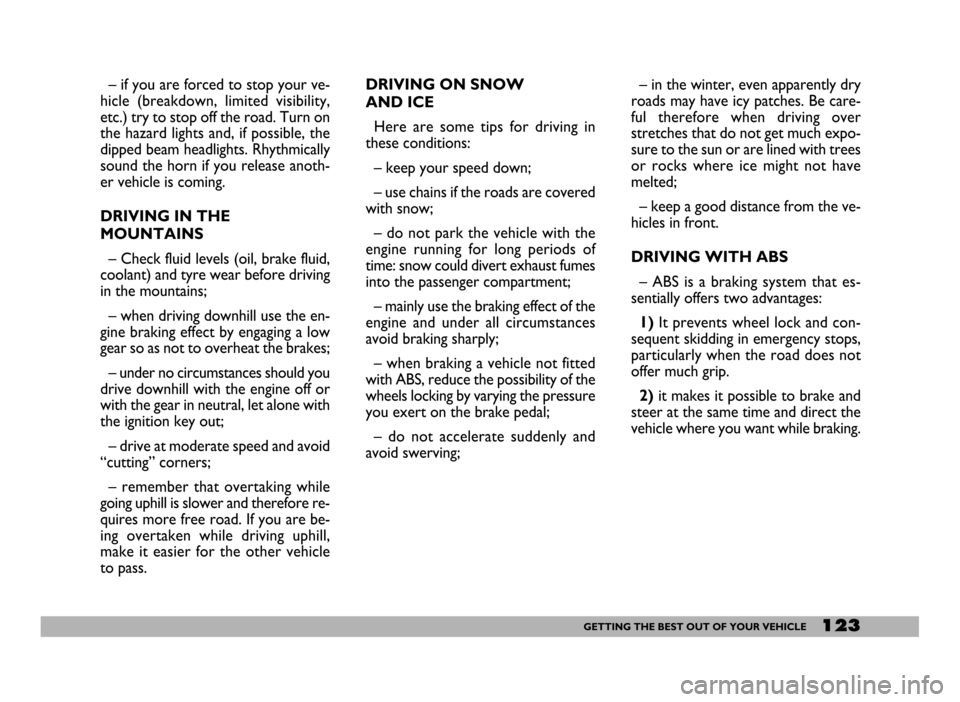
123GETTING THE BEST OUT OF YOUR VEHICLE
– if you are forced to stop your ve-
hicle (breakdown, limited visibility,
etc.) try to stop off the road. Turn on
the hazard lights and, if possible, the
dipped beam headlights. Rhythmically
sound the horn if you release anoth-
er vehicle is coming.
DRIVING IN THE
MOUNTAINS
– Check fluid levels (oil, brake fluid,
coolant) and tyre wear before driving
in the mountains;
– when driving downhill use the en-
gine braking effect by engaging a low
gear so as not to overheat the brakes;
– under no circumstances should you
drive downhill with the engine off or
with the gear in neutral, let alone with
the ignition key out;
– drive at moderate speed and avoid
“cutting” corners;
– remember that overtaking while
going uphill is slower and therefore re-
quires more free road. If you are be-
ing overtaken while driving uphill,
make it easier for the other vehicle
to pass.DRIVING ON SNOW
AND ICE
Here are some tips for driving in
these conditions:
– keep your speed down;
– use chains if the roads are covered
with snow;
– do not park the vehicle with the
engine running for long periods of
time: snow could divert exhaust fumes
into the passenger compartment;
– mainly use the braking effect of the
engine and under all circumstances
avoid braking sharply;
– when braking a vehicle not fitted
with ABS, reduce the possibility of the
wheels locking by varying the pressure
you exert on the brake pedal;
– do not accelerate suddenly and
avoid swerving;– in the winter, even apparently dry
roads may have icy patches. Be care-
ful therefore when driving over
stretches that do not get much expo-
sure to the sun or are lined with trees
or rocks where ice might not have
melted;
– keep a good distance from the ve-
hicles in front.
DRIVING WITH ABS
– ABS is a braking system that es-
sentially offers two advantages:
1) It prevents wheel lock and con-
sequent skidding in emergency stops,
particularly when the road does not
offer much grip.
2) it makes it possible to brake and
steer at the same time and direct the
vehicle where you want while braking.
Page 165 of 258
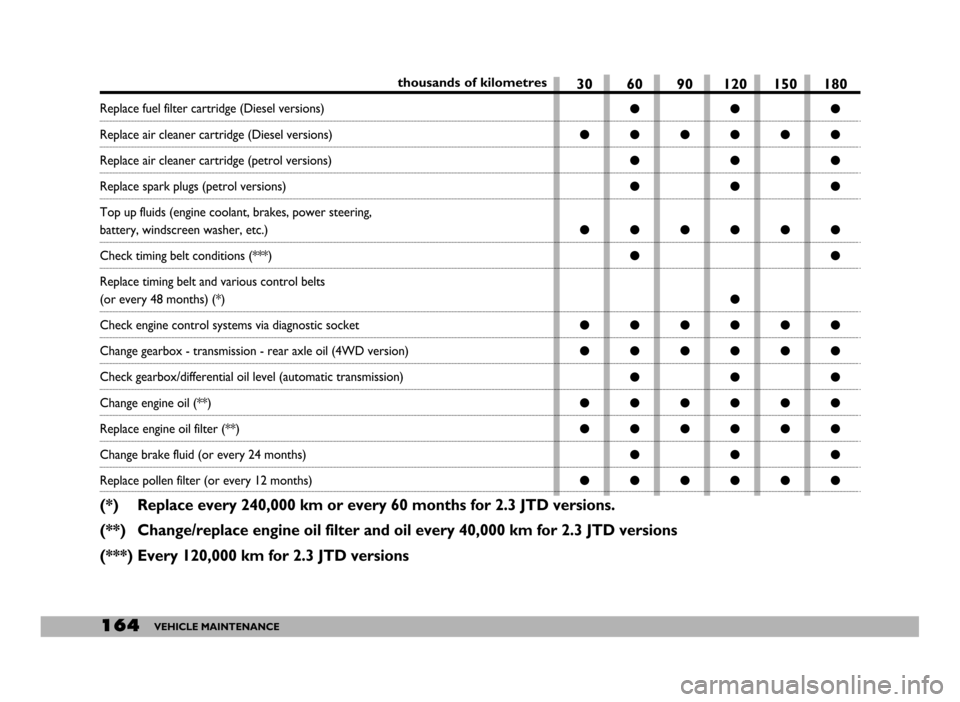
164VEHICLE MAINTENANCE
thousands of kilometres
Replace fuel filter cartridge (Diesel versions)
Replace air cleaner cartridge (Diesel versions)
Replace air cleaner cartridge (petrol versions)
Replace spark plugs (petrol versions)
Top up fluids (engine coolant, brakes, power steering,
battery, windscreen washer, etc.)
Check timing belt conditions (***)
Replace timing belt and various control belts
(or every 48 months) (*)
Check engine control systems via diagnostic socket
Change gearbox - transmission - rear axle oil (4WD version)
Check gearbox/differential oil level (automatic transmission)
Change engine oil (**)
Replace engine oil filter (**)
Change brake fluid (or every 24 months)
Replace pollen filter (or every 12 months)
(*) Replace every 240,000 km or every 60 months for 2.3 JTD versions.
(**) Change/replace engine oil filter and oil every 40,000 km for 2.3 JTD versions
(***) Every 120,000 km for 2.3 JTD versions
30 60 90 120 150 180
●●●
●●●●●●
●●●
●●●
●●●●●●
●●
●
●●●●●●
●●●●●●
●●●
●●●●●●
●●●●●●
●●●
●●●●●●
Page 166 of 258
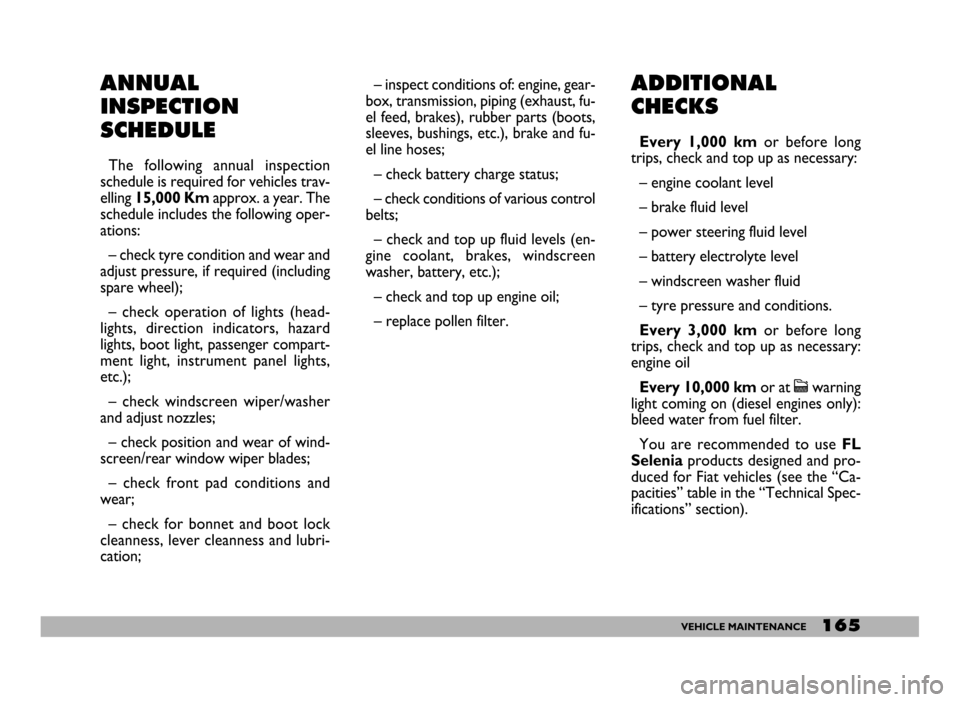
165VEHICLE MAINTENANCE
ANNUAL
INSPECTION
SCHEDULE
The following annual inspection
schedule is required for vehicles trav-
elling 15,000 Kmapprox. a year. The
schedule includes the following oper-
ations:
– check tyre condition and wear and
adjust pressure, if required (including
spare wheel);
– check operation of lights (head-
lights, direction indicators, hazard
lights, boot light, passenger compart-
ment light, instrument panel lights,
etc.);
– check windscreen wiper/washer
and adjust nozzles;
– check position and wear of wind-
screen/rear window wiper blades;
– check front pad conditions and
wear;
– check for bonnet and boot lock
cleanness, lever cleanness and lubri-
cation;– inspect conditions of: engine, gear-
box, transmission, piping (exhaust, fu-
el feed, brakes), rubber parts (boots,
sleeves, bushings, etc.), brake and fu-
el line hoses;
– check battery charge status;
– check conditions of various control
belts;
– check and top up fluid levels (en-
gine coolant, brakes, windscreen
washer, battery, etc.);
– check and top up engine oil;
– replace pollen filter.
ADDITIONAL
CHECKS
Every 1,000 km or before long
trips, check and top up as necessary:
– engine coolant level
– brake fluid level
– power steering fluid level
– battery electrolyte level
– windscreen washer fluid
– tyre pressure and conditions.
Every 3,000 km or before long
trips, check and top up as necessary:
engine oil
Every 10,000 kmor at cwarning
light coming on (diesel engines only):
bleed water from fuel filter.
You are recommended to use FL
Seleniaproducts designed and pro-
duced for Fiat vehicles (see the “Ca-
pacities” table in the “Technical Spec-
ifications” section).
Page 168 of 258
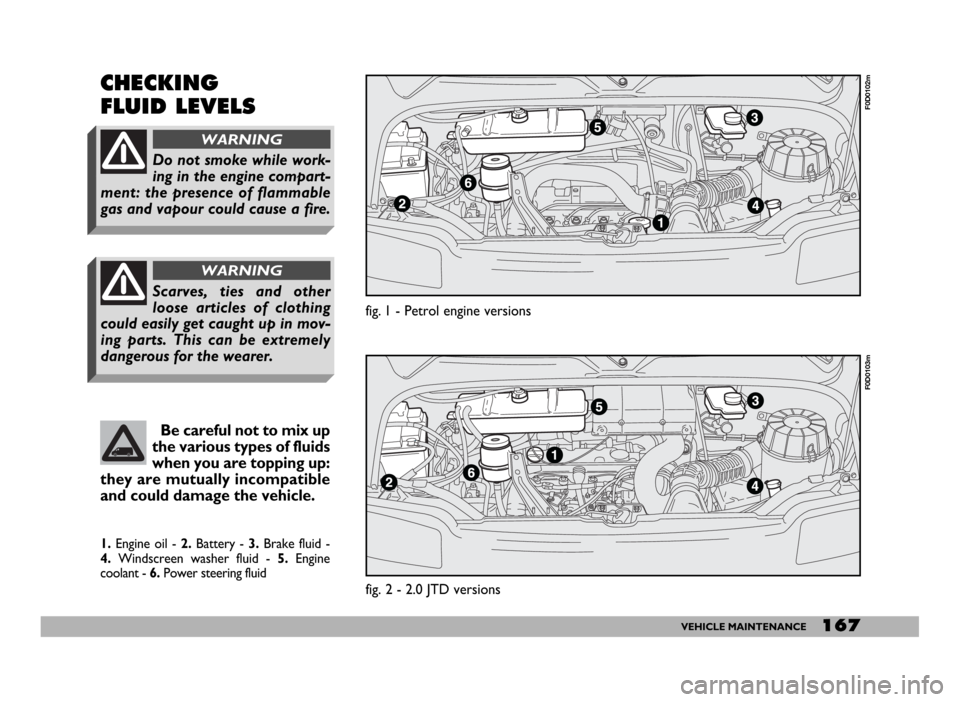
167VEHICLE MAINTENANCE
1. Engine oil - 2. Battery - 3. Brake fluid -
4. Windscreen washer fluid - 5. Engine
coolant - 6.Power steering fluid
F0D0103m
fig. 2 - 2.0 JTD versions
F0D0102m
fig. 1 - Petrol engine versions
CHECKING
FLUID LEVELS
Be careful not to mix up
the various types of fluids
when you are topping up:
they are mutually incompatible
and could damage the vehicle.
Do not smoke while work-
ing in the engine compart-
ment: the presence of flammable
gas and vapour could cause a fire.
WARNING
Scarves, ties and other
loose articles of clothing
could easily get caught up in mov-
ing parts. This can be extremely
dangerous for the wearer.
WARNING
Page 171 of 258
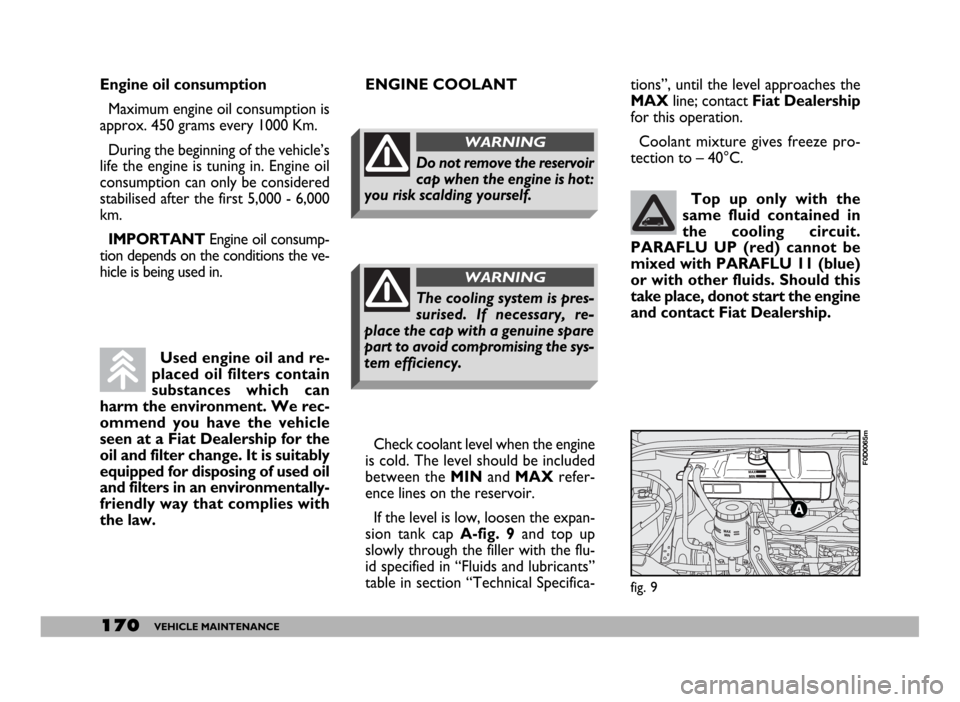
170VEHICLE MAINTENANCE
Engine oil consumption
Maximum engine oil consumption is
approx. 450 grams every 1000 Km.
During the beginning of the vehicle’s
life the engine is tuning in. Engine oil
consumption can only be considered
stabilised after the first 5,000 - 6,000
km.
IMPORTANTEngine oil consump-
tion depends on the conditions the ve-
hicle is being used in.ENGINE COOLANT
Check coolant level when the engine
is cold. The level should be included
between the MIN and MAXrefer-
ence lines on the reservoir.
If the level is low, loosen the expan-
sion tank cap A-fig. 9and top up
slowly through the filler with the flu-
id specified in “Fluids and lubricants”
table in section “Technical Specifica-tions”, until the level approaches the
MAX line; contact Fiat Dealership
for this operation.
Coolant mixture gives freeze pro-
tection to – 40°C.
Used engine oil and re-
placed oil filters contain
substances which can
harm the environment. We rec-
ommend you have the vehicle
seen at a Fiat Dealership for the
oil and filter change. It is suitably
equipped for disposing of used oil
and filters in an environmentally-
friendly way that complies with
the law.
fig. 9
F0D0065m
The cooling system is pres-
surised. If necessary, re-
place the cap with a genuine spare
part to avoid compromising the sys-
tem efficiency.
WARNING
Do not remove the reservoir
cap when the engine is hot:
you risk scalding yourself.
WARNING
Top up only with the
same fluid contained in
the cooling circuit.
PARAFLU UP (red) cannot be
mixed with PARAFLU 11 (blue)
or with other fluids. Should this
take place, donot start the engine
and contact Fiat Dealership.
Page 248 of 258
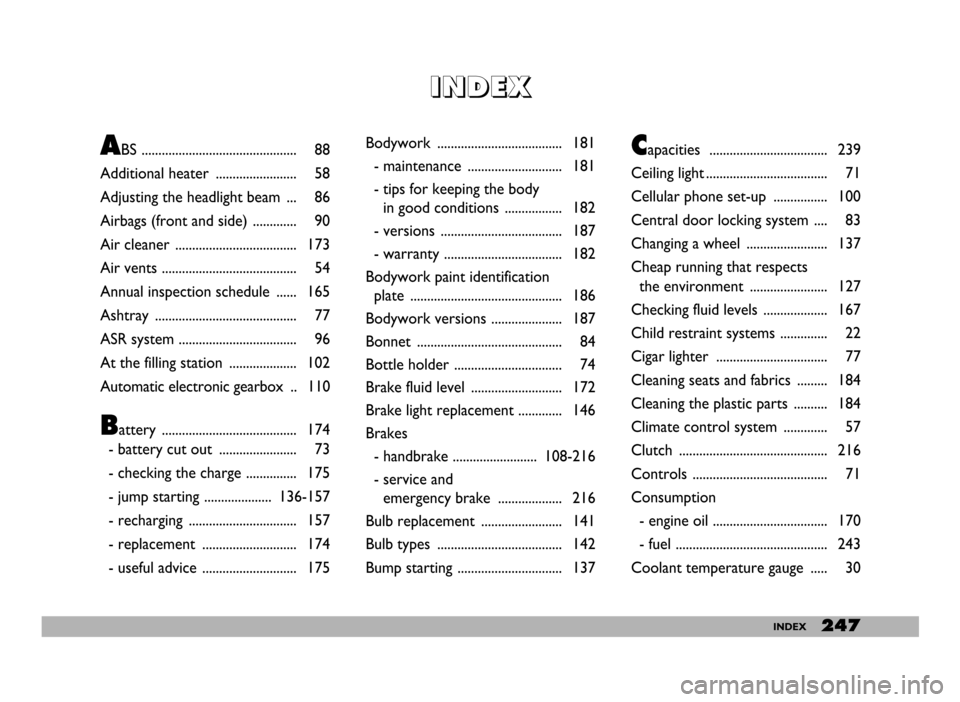
247INDEX
I I
N N
D D
E E
X X
Bodywork ..................................... 181
- maintenance ............................ 181
- tips for keeping the body
in good conditions ................. 182
- versions .................................... 187
- warranty ................................... 182
Bodywork paint identification
plate ............................................. 186
Bodywork versions ..................... 187
Bonnet ........................................... 84
Bottle holder ................................ 74
Brake fluid level ........................... 172
Brake light replacement ............. 146
Brakes
- handbrake ......................... 108-216
- service and
emergency brake ................... 216
Bulb replacement ........................ 141
Bulb types ..................................... 142
Bump starting ............................... 137Capacities ................................... 239
Ceiling light .................................... 71
Cellular phone set-up ................ 100
Central door locking system .... 83
Changing a wheel ........................ 137
Cheap running that respects
the environment ....................... 127
Checking fluid levels ................... 167
Child restraint systems .............. 22
Cigar lighter ................................. 77
Cleaning seats and fabrics ......... 184
Cleaning the plastic parts .......... 184
Climate control system ............. 57
Clutch ............................................ 216
Controls ........................................ 71
Consumption
- engine oil .................................. 170
- fuel ............................................. 243
Coolant temperature gauge ..... 30ABS .............................................. 88
Additional heater ........................ 58
Adjusting the headlight beam ... 86
Airbags (front and side) ............. 90
Air cleaner .................................... 173
Air vents ........................................ 54
Annual inspection schedule ...... 165
Ashtray .......................................... 77
ASR system ................................... 96
At the filling station .................... 102
Automatic electronic gearbox .. 110
Battery ........................................ 174
- battery cut out ....................... 73
- checking the charge ............... 175
- jump starting .................... 136-157
- recharging ................................ 157
- replacement ............................ 174
- useful advice ............................ 175